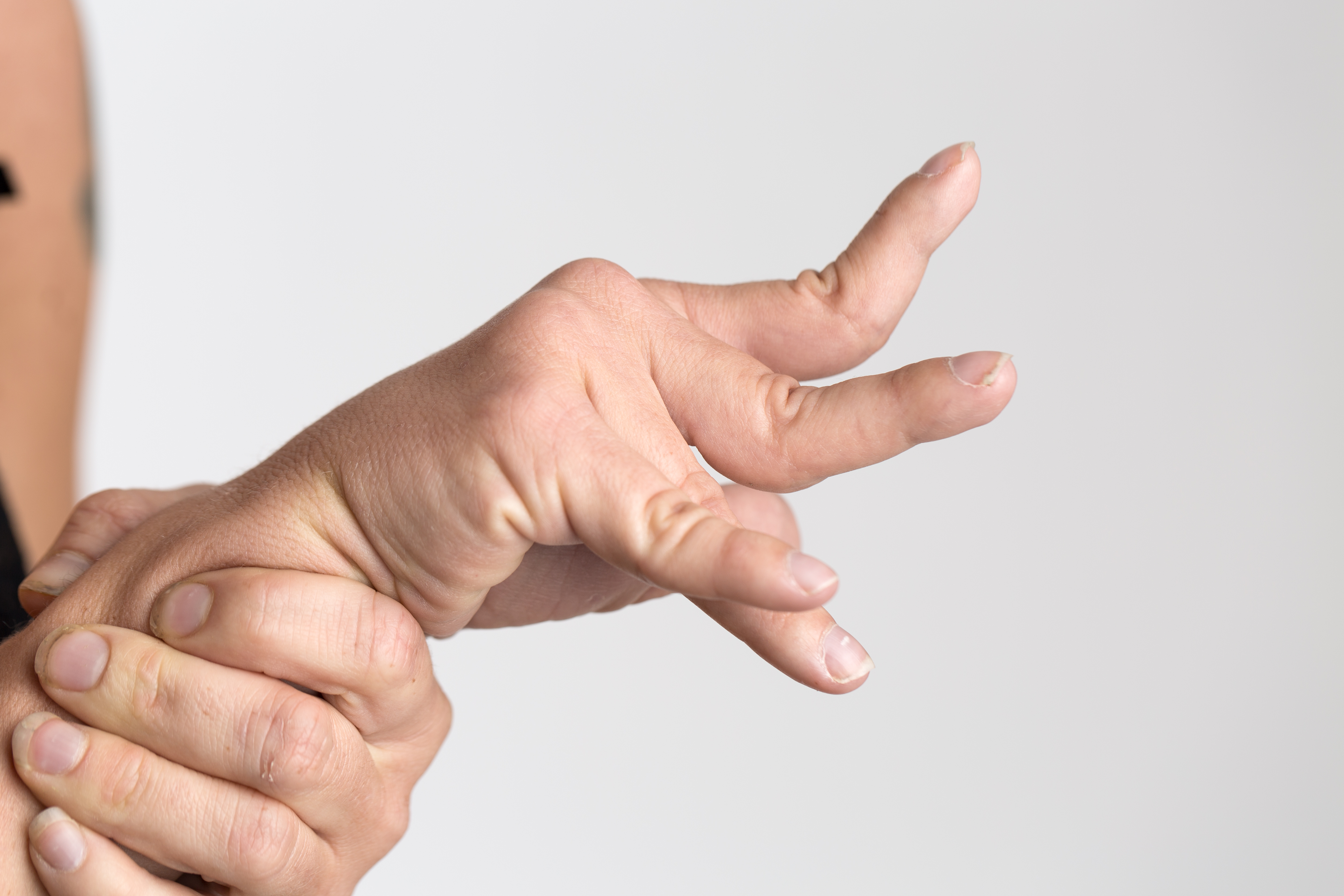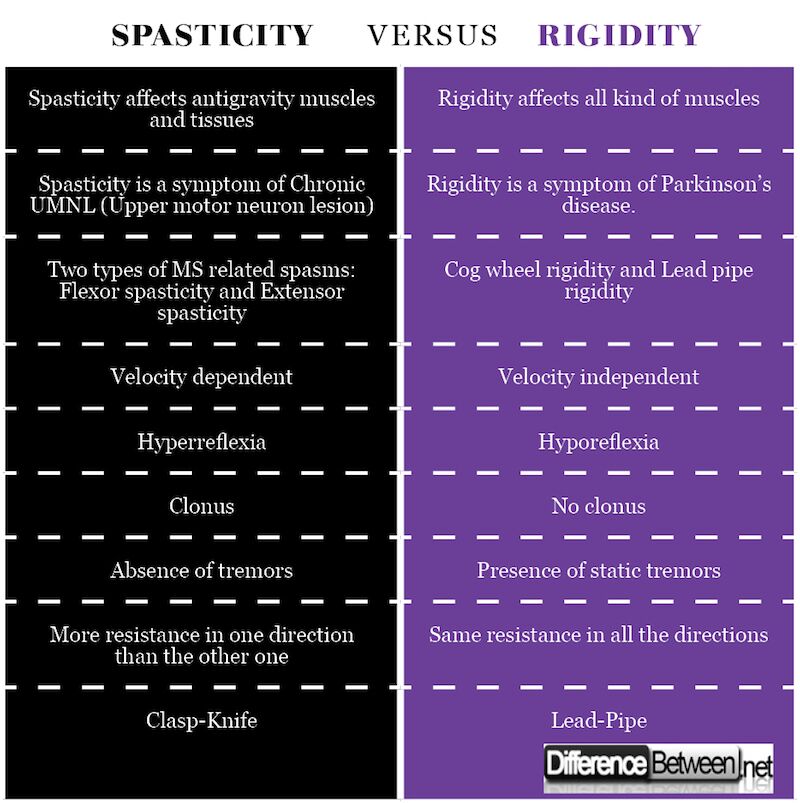Difference between Spasticity and Rigidity
What is Spasticity?
Spasticity in Greek means “pulling”. Spasticity is a condition where a number of muscles suffer continuous contraction, stiffness, and tightness. It is caused by lesions in the pyramidal tract i.e. UMNL (Upper Motor neuron lesion). Spasticity is characterized by spasm, especially the tonic spasm. This kind of stiffness or spasm interferes with the speech, normal movement and gait. Spasticity is uni-directional, i.e. the resilience to motion is only experienced when the joint or a muscle makes a move in some particular direction. Spasticity is a common symptom of a demyelinating disease called as Multiple Sclerosis (MS) and is termed as muscle stiffness. In this disease, the neuron cells of the brain and spinal cord suffer damage. Spasticity is dependent on velocity i.e. it can be noticed with fast movements.

What are the causes of spasticity?
- Spasticity takes place when the messages from the central nervous system are not transmitted properly to the spinal cord and the muscles, due to the degradation of the paths between the brain system, the spinal cord and the muscles being
- It is also caused due to the progressive degeneration of myelin and the nerve fibers.Myelin is a fatty white substance that envelops the axon of nerve cells, forming an electrically insulating membrane.
- Spasticity also takes place due to contraction of the extensor muscles and the flexor muscles that causes pain and weak coordination.
- Multiple sclerosis
- Acquired brain trauma
- Stroke
- Cerebral palsy
What are the symptoms of spasticity?
- Hypertonicity i.e. rising muscle tone, that causes stiffness, rigidity and dysfunctional bladder.
- Uncontrollable muscle spasms (called clonus)
- Exaggerated tendon reflexes (tense muscles)
- Nocturnal awakening
- Deformity causing difficulty in walking, moving and speech.
- Abnormal positioning of arm, wrist, fingers, and shoulder.
- Involuntary jerky movement.
What is Rigidity?
It is defined as a state of stiffness, inflexibility, and inability to bend, stretch, twist or any deformity under pressure. Rigidity is also known as muscle tension or rigor. Rigidity is mostly bi-directional, i.e. resistance to movement in muscles is felt regardless of speed and course of direction in which the muscles and tissues exhibit their motion. Rigidity can be seen in extrapyramidal lesions, (part of the motor system causing involuntary actions) for example Parkinson’s disease. Parkinson’s disease is a progressive neurological disease which affects movement.

What are the causes of Rigidity?
- Parkinson’s disease
- Wilson’s disease (Autosomal recessive condition inherited of copper metabolism in lungs, liver, brain and other tissues.
- Multiple system atrophy
- DMD (Dystonia musculorum deformans). This is a disease where painful muscle contractions cause exaggerated distortions.
- MNS (Neuroleptic-malignant syndrome). This is a life-threatening disease. It is described as idiosyncratic reaction toneurolepticmedications.
- Catatonia (State of unresponsiveness to external stimuli).
- CJD (Creutzfeldt-Jakob disease i.e. fatal brain disorder).
- Progressive supranuclear palsy or Steele-Richardson-Olszewski syndrome
- Acute cerebral infraction
- Multiple system atrophy (MSA) or Shy-drager syndrome (neurodegenerativedisorder due to dysfunction of autonomic nervous system)
- Basal ganglia infection
- Gegenhalten (involuntary resistance to passive movements).
- lupus, (a chronic inflammatory disease that causes pain and stiffness in the joints)
- Pinched nerves
- Viral and bacterial infections.
What are the symptoms of rigidity?
- Bradykinesia (impaired ability and slowness of movement)
- Stiff and inflexible muscles
- Pain, severe muscle weakness and muscle cramps
- Decreased movement
- A fixedfacial expression called a “mask”
- Difficulty moving in bed
- Difficulty getting up from a chair
- Trouble in writing, walking and clothe buttoning Restlessness and irritability
- Decreased appetite
- Difficulty in breathing
- High fever
Difference between Spasticity and Rigidity
1) Definition Spasticity and Rigidity
Spasticity
Continuous contraction of muscles
Rigidity
The state of stiffness, inflexibility and inability to bend.
2) Type of muscles that are affected
Spasticity
Spasticity commonly affects muscles of legs and arms, neck. Eyelids, face, and vocal chords. It can be also said that spasticity involves only one muscle group i.e. Flexors.
Rigidity
Rigidity can affect any muscle of the body, i.e. both Flexors and Extensors.
Symptoms of Spasticity and Rigidity
Spasticity
Symptoms of spasticity include alleviated functional abilities, unusual posture, pain in joints, persistent stiffness and contractures, non-progressive motor growth, deformities in joints and bones and excessively active reflexes
Rigidity
Symptoms of rigidity include stiffness, inflexibility of muscles, cramps, mask (fixed facial expression), inability to write and clothe buttoning, trouble to get up from a chair or bed and pain.
3) Velocity dependence
Spasticity
Spasticity depends on velocity. This means that spasticity is more noticeable with fast movements. It exhibits abnormally high muscle tone due to the excitability of the stretch reflex.
Rigidity
Rigidity is not dependent on the velocity of the movement. In this, the resistance of a joint is unaffected by the speed of movement of muscles.
4) Lesions in Spasticity and Rigidity
Spasticity
Spasticity is found in pyramidal tract lesions (Upper motor neuron lesion).
Rigidity
Rigidity is found in extrapyramidal lesions, (i.e. parkinsonism) like the rubrospinal or vestibulospinal tracts.
5) Reflexes
Spasticity
Spasticity covaries with Hyperreflexia. Hyperreflexia is a condition in which involuntary nervous system shows a disordered response to external stimuli. It is caused due to spinal cord lesion or injury.
Rigidity
Rigidity covaries with Hyporeflexia. Hyporeflexia is a condition in which there is weak or diminished reflex in reaction to some external stimuli.
Summary of Spasticity and Rigidity
The points of difference between Spasticity and Rigidity have been summarized below:

Two common cases of resistance to movement are spasticity and rigidity. Both of them demonstrate hypertonic conditions, however, their causes, symptoms, and attributes differ. These two states are elicited while examining the tone of muscle limbs. Spasticity features include clonus and increased reflexes while as the features of rigidity include mental state, alertness, and emotions.
- Difference Between Global Warming and Greenhouse Effect - May 18, 2024
- Difference Between Vaccination and Immunization - March 3, 2024
- Difference Between Selective Mutism and Autism - February 25, 2024
Search DifferenceBetween.net :
1 Comment
Leave a Response
References :
[0]IMAGE CREDIT: https://upload.wikimedia.org/wikipedia/commons/thumb/d/d7/A_treatise_on_orthopedic_surgery_%281903%29_%2814578575997%29.jpg/671px-A_treatise_on_orthopedic_surgery_%281903%29_%2814578575997%29.jpg
[1]IMAGE CREDIT: https://upload.wikimedia.org/wikipedia/commons/9/99/Spastic_hand_1.jpg
[2]Bhimani, R., & Anderson, L. (2014). Clinical understanding of spasticity: implications forpractice.Rehabilitation research and practice,2014
[3]Sanger, T. D., Delgado, M. R., Gaebler-Spira, D., Hallett, M., & Mink, J. W. (2003).Classification and definition of disorders causing hypertonia in childhood.Pediatrics,111(1),e89-e97
[4]Vijayalakshmi, G. (2017). Traumatic brain injury-a Neuro-behavioural sequelae areview.Journal of evolution of medical and dental sciences-jemds,6(26), 2192-2207

Hi when I was 4 I fell down a flight of stairs which caused atlas subluxation. My whole life I felt horrible muscle pains that would go away. Legs stomach but mostly neck. I would go to a chiropractor who adjusted by third vertebra but never the atlas. 36 years later my body started to go numb and I had pain in all my body. Nobody could find a cause until an upper cervical chiropractor checked me out. My atlas was out 4 and 3/4 a degree. It’s been 11 years now and I need to get my atlas adjusted often. My chiropractor also does a technique called Alexander which helps train my tight muscles to relax. I finally self diagnosed myself with rigidity. I am slowly getting better through chiropractor NUCCA and Alexander and more recently I have been able to stretch and play sports which helps. My question is would drugs help me as well. I read there are drugs that can help with rigidity. Also what kind of doctor would I go to if this would help?